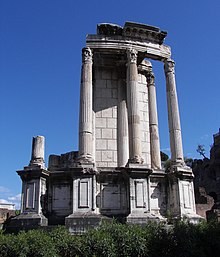Temple of Vesta
Coordinates: 41°53′30″N 12°29′11″E / 41.891664°N 12.486262°E / 41.891664; 12.486262
| Temple of Vesta | |
|---|---|
 Remains of the Temple of Vesta | |
| Location | Regione VIII Forum Romanum |
| Built in | unknown old Kingdom era |
| Built by/for | Unknown builder |
| Type of structure | Roman Old kingdom |
| Related | List of ancient monuments in Rome |
 Temple of Vesta | |
The Temple of Vesta (Latin Aedes Vestae; Italian: Tempio di Vesta) is an ancient edifice in Rome, Italy, located in the Roman Forum near the Regia and the House of the Vestal Virgins. The temple's most recognizable feature is its circular footprint. Since the worship of Vesta began in private homes, the architecture seems to be a reminder of its history. The extant temple used Greek architecture with Corinthian columns, marble, and a central cella. The remaining structure indicates that there were twenty Corinthian columns built on a podium fifteen meters in diameter. The roof probably had a vent at the apex to allow smoke release.

The most prominent feature of the ruins that were once the Temple of Vesta is the hearth.
Contents
1 History
2 Reconstructions
3 See also
4 References
4.1 Modern sources
5 External links
History

Brick with the emblem of Theodoric the Great, found in the temple of Vesta.
All temples to Vesta were round, and had entrances facing east to symbolize connection between Vesta’s fire and the sun as sources of life. The Temple of Vesta represents the site of ancient cult activity as far back as 7th century BCE. Numa Pompilius is believed to have built this temple along with the original Regia and House of the Vestal Virgins in its original form. Around the Temple stood The Sacred Grove, in which also there was a graveyard for the priests and virgins.[1]
It was one of the earliest structures located in the Roman Forum although its present reincarnation is the result of subsequent rebuilding. Instead of a cult statue in the cella, there was a hearth which held the sacred flame.[2] The temple was the storehouse for the legal wills and documents of Roman Senators and cult objects such as the Palladium. The Palladium was a statue of Athena (Roman Minerva) believed to have been brought by Aeneas from Troy; the statue was felt to be one of the Pignora Imperii, or pledges of imperium, of Ancient Rome.[3] That the Romans believed that the Sacred fire of Vesta was closely tied to the fortunes of the city and viewed its extinction as a portent of disaster has been agreed on by all ancient accounts.[4] The temple was closed during the persecution of pagans in the late Roman Empire in the 4th-century.
Reconstructions
The temple was rebuilt many times, for it was destroyed many times. The first destruction of the temple was by the Gauls in 390 BCE.[5] According to Ovid, the second time was in 241 BCE; after fire destroyed much of Vesta's temple, Lucius Caecilius Metellus who was Pontifex Maximus at the time, saved the palladium and according to tradition was blinded in the incident.[6] Such fires occurred again in 210 BCE and again in the early first century BCE; however, the building was safe. It was rebuilt again during the reigns of Augustus and Nero. Finally, it burnt down in 191 CE and was later built for the last time during the reign of Septimius Severus.[7]
The Temple of Vesta remained reasonably intact until the Renaissance. However, in 1549 CE, the building was completely demolished and its marble reused in churches and papal palaces.[8] The section standing today was reconstructed in the 1930s during the dictatorship of Benito Mussolini.[9]
See also
- The round Temple of Hercules Victor in the Forum Boarium was initially thought to be a temple of Vesta.
- The Temple of Vesta, Tivoli
References
^ Charlotte Anne Eaton, Rome in the Nineteenth Century - 1822 "At the base of the Palatine Hill, surrounded with the Sacred Grove, and enclosed with a wall, stood the Temple of Vesta, and the House of the Vestal Virgins, to which the Regia of Numa served as a portico."
^ Middleton 1892, p. 295
^ Howatson 2011, p. 590
^ Wildfang 2006, p. 6
^ Middleton 1886, p. 395
^ Ovid Fas. VI 437-454.
^ Stamper 2005, p. 228
^ Gorski & Packer 2015, p. 317
^ Brockman 2011, p. 587
Modern sources
Brockman, Norbert (2011), Encyclopedia of Sacred Places, 1, ABC-CLIO, ISBN 978-1-59884-654-6.mw-parser-output cite.citation{font-style:inherit}.mw-parser-output q{quotes:"""""""'""'"}.mw-parser-output code.cs1-code{color:inherit;background:inherit;border:inherit;padding:inherit}.mw-parser-output .cs1-lock-free a{background:url("//upload.wikimedia.org/wikipedia/commons/thumb/6/65/Lock-green.svg/9px-Lock-green.svg.png")no-repeat;background-position:right .1em center}.mw-parser-output .cs1-lock-limited a,.mw-parser-output .cs1-lock-registration a{background:url("//upload.wikimedia.org/wikipedia/commons/thumb/d/d6/Lock-gray-alt-2.svg/9px-Lock-gray-alt-2.svg.png")no-repeat;background-position:right .1em center}.mw-parser-output .cs1-lock-subscription a{background:url("//upload.wikimedia.org/wikipedia/commons/thumb/a/aa/Lock-red-alt-2.svg/9px-Lock-red-alt-2.svg.png")no-repeat;background-position:right .1em center}.mw-parser-output .cs1-subscription,.mw-parser-output .cs1-registration{color:#555}.mw-parser-output .cs1-subscription span,.mw-parser-output .cs1-registration span{border-bottom:1px dotted;cursor:help}.mw-parser-output .cs1-hidden-error{display:none;font-size:100%}.mw-parser-output .cs1-visible-error{font-size:100%}.mw-parser-output .cs1-subscription,.mw-parser-output .cs1-registration,.mw-parser-output .cs1-format{font-size:95%}.mw-parser-output .cs1-kern-left,.mw-parser-output .cs1-kern-wl-left{padding-left:0.2em}.mw-parser-output .cs1-kern-right,.mw-parser-output .cs1-kern-wl-right{padding-right:0.2em}
Gorski, Gilbert J.; Packer, James E. (2015), The Roman Forum: A Reconstruction and Architectural Guide, Cambridge University Press, ISBN 978-0-521-19244-6
Howatson, M. C. (2011), The Oxford Companion to Classical Literature (Third ed.), Oxford University Press, ISBN 978-0-19-954855-2
Middleton, John Henry (1886). "The Temple and Atrium of Vesta and the Regia". Archaeologia: 395.
Middleton, John Henry (1892), The Remains of Ancient Rome, 1
Stamper, John W. (2005), The Architecture of Roman Temples: The Republic to the Middle Empire, Cambridge University Press, ISBN 0 521 81068 X
Wildfang, Robin Lorsch (2006), Rome's Vestal Virgins, Routledge, ISBN 978-0-415-39795-7
External links
- Aedes Vestae - Temple of Vesta - Tempio di Vesta, Reconstructed